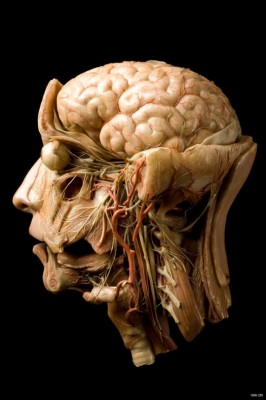Human brains are pretty amazing. Even though a typical brain accounts for only 2% of a person’s mass, it uses 20% of that person’s energy. Brains use this energy to form and recall memories, make complex decisions, take in loads of sensory information and maintain a coherent personality. Even when you’re sleeping, your brain is hard at work.

After a close call on my cycle into work last week, I started to wonder how protected my brain really was, even with a helmet.
Modern helmets are pretty good at preventing skull damage such as fractures, cuts and scrapes. But a hit to the head can cause your brain to move inside your skull, as the brain has a jelly-like consistency and is surrounded by cerebrospinal fluid. If the movement is dramatic enough to make your brain hit the inside of your skull, it can cause serious damage, including concussion.
It’s long been known that repeated blows to the head are bad for you, but only recently has a link been acknowledged between contact sports such as American football and a degenerative brain disease called chronic traumatic encephalopathy (CTE). The disease causes all sorts of symptoms, from dizziness and loss of attention, to forgetfulness, poor judgement and mood swings. The disease was common in boxing, hence the old name: dementia pugilistica, or punch-drunk syndrome.
The disease has gained attention recently because of a 2015 film starring Will Smith that dramatises the discovery of the link between CTE and American football by Dr Bennet Omalu. There’s also been a multi-million-dollar lawsuit in the USA between players affected by the disease and the US National Football League. But head knocks are nothing new, and some researchers think there’s a compelling case to be made that Henry VIII might have developed CTE after falling from his horse.
So how can brain movement be reduced?
It’s a tricky proposition because it happens inside the skull, but American researchers at Q30 Innovations think they might have found a solution.
Inspired by the way woodpeckers and bighorn sheep survive repeated blows to the head, they have designed a collar that slightly increases the amount of blood in the head. This extra blood acts as a cushion for the brain, and you can see this collar on display in the Science Museum.

I asked Tom Hoey, the CEO of Q30, about why he got involved in the development of the Q-collar, ‘When I saw the early technology I knew I had to get involved. I grew up playing sports and it was hugely important for me. Now that my kids are playing sports, it’s even more important for me that kids can stay active without compromising their safety. We’re one of the first groups to start working on prevention rather than diagnosis and treatment.’
Protecting the brain has come a long way. Not only are modern helmets much better designed than their older counterparts, but we also have a better understanding of the mechanics and consequences of brain injuries. That said, there’s still a lot we don’t know: at the moment the only way to definitively diagnose CTE is by dissecting a brain after death; research into the safety and effectiveness of the Q-collar is also ongoing.
All this talk of brain injury has made me appreciate how important and fragile my brain is, so I’ll definitely continue to wear a helmet when I cycle. You might also see me sporting a new neck accessory if it becomes commercially available.
If you would like to find out more, the Q-collar will be on display at the Science Museum from 17 May in the Antenna gallery for a couple of months.